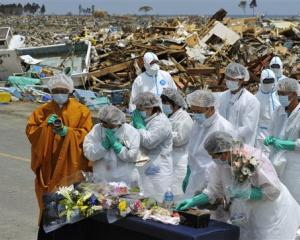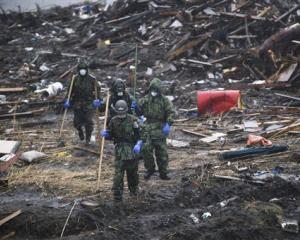
Restoring the power to all six units at the tsunami-damaged complex is key, because it will, in theory, power up the maze of motors, valves and switches that help deliver cooling water to the overheated reactor cores and spent fuel pools that are leaking radiation.
Ideally, officials believe it should only take a day to get the Fukushima Dai-ichi nuclear under control once the cooling system is up and running. In reality, the effort to end the crisis is likely to take weeks.
Late last night, the deputy director general of Japan's nuclear safety body suggested to reporters why there is so much uncertainty about when the job will be finished.
"We have experienced a very huge disaster that has caused very large damage at a nuclear power generation plant on a scale that we had not expected," said Hidehiko Nishiyama of the Nuclear and Industrial Safety Agency.
The nuclear plant's cooling systems were wrecked by the massive earthquake and tsunami that devastated northeastern Japan on March 11. Since then, conditions at the plant have been volatile; a plume of smoke rose from two reactor units Monday, prompting workers to evacuate.
In another setback, the plant's operator said today it had just discovered that some of the cooling system's key pumps at the complex's troubled Unit 2 are no longer functional - meaning replacements have to be brought in. Tokyo Electric Power said it had placed emergency orders for new pumps, but how long it would take for them to arrive was unclear.
If officials can get the power turned on, get the replacement pumps working and get enough seawater into the reactors and spent fuel pools, it would only take a day to bring the temperatures back to a safe, cooling stage, said Ryohei Shiomi, an official with the Nuclear and Industrial Safety Agency.
And if not?
"There is nothing else we can do but keep doing what we've been doing," Shiomi said.
In other words, officials would continue dousing the plant in seawater - and hope for the best.
An official of the US Nuclear Regulatory Commission said in Washington that Units 1, 2 and 3 have all seen damage to their reactor cores, but that containment is intact. The assessment dispels some concerns about Unit 2, where an explosion damaged a pressure-reducing chamber around the bottom of the reactor core.
"I would say optimistically that things appear to be on the verge of stabilizing," said Bill Borchardt, the commission's executive director for operations.
Monday's evacuation of workers from the plant came after smoke began rising from the spent fuel storage pool of the plant's problem-plagued Unit 3, Tokyo Electric spokesman Hiroshi Aizawa said. Unit 3 also alarmed plant officials over the weekend with a sudden surge of pressure in its reactor core.
What caused the smoke to billow first from Unit 3 and then from Unit 2 is under investigation, nuclear safety agency officials said. Still, in the days since the earthquake and tsunami, both reactors have overheated and seen explosions. Workers were evacuated from the area to buildings nearby, though radiation levels remained steady, the officials said.
Problems set off by the disasters have ranged far beyond the shattered northeast coast and the wrecked nuclear plant, handing the government what it has called Japan's worst crisis since World War II. Rebuilding may cost as much as $235 billion. Police estimate the death toll will surpass 18,000.
Traces of radiation are tainting vegetables and some water supplies, although in amounts the government and health experts say do not pose a risk to human health in the short term. That has caused the government to ban sale of raw milk, spinach and canola from prefectures over a swath from the plant toward Tokyo. The government has just started to test fish and shellfish.
Tokyo Electric said radioactive iodine about 127 times normal levels and radioactive cesium about 25 times above the norm were detected in seawater 100m off the Fukushima nuclear plant.








